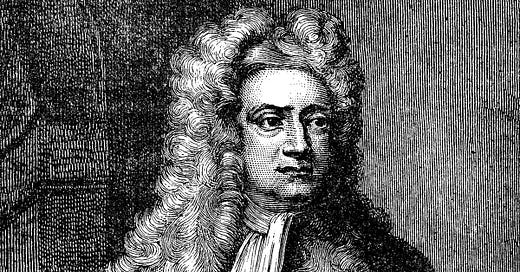This is the first article in a four-part series on cap tables:
#7 Episode—Universal Cap Tables (9/16/20)
#9 Episode—Mutable Laws of VC (10/4/20)
#10 Episode—The Stories Behind Cap Tables (10/13/20)
There are three elements behind every cap table: (1) The Math; (2) The Law; and (3) The Story.
Math has three unique attributes:
First, math is the only true, universal language. A phrase or formula has the same meaning, regardless of another person’s language.
Second, math transcends time. Math from Isaac Newton's time can be solved the same way today as it was back then.
Third, math compounds. Newton said it best in 1675: "If I could have seen further it is because I'm standing on the shoulders of Giants."
Law is fundamentally different than mathematics. It's fluid, subjective & moored to a society's language and its values. Just like any language, law is more art than science. Its word structure, terminology, etymology and meaning are highly dependent upon the context. Lady Justice has a blindfold and scales, not a telescope and an abacus.
The Story is the most overlooked element of a cap table. And yet, it's also the most important; precisely because it is hidden in plain sight.
Let's look at the life of Isaac Newton.
Isaac Newton was the most gifted scientist to ever roam this Earth. Yet his life and contributions to humanity were far from certain. From his biography by the Khan Academy and The BBC:
On December 25th, 1642, Newton was born prematurely and given little chance to survive. His dad died before he was born. At the age of 3, his mother remarried and his grandparents raised him on a farm. At that time, England was being torn apart by civil war.
When Newton was 11 years old, his mother returned home and sent him off to boarding school. The headmaster quickly recognized young Newton’s talents and convinced his mother to prepare Newton for college.
From 1661 to 1664, Newton attended Cambridge University. In 1664, the university shut down due to the Great Plague. The epidemic killed nearly a fifth of London's population. In 1666, a fire broke out in London razing over 13,000 homes. Newton retreated to his grandparents’ farm once again.
Over the next two years, while in quarantine, Newton developed the laws of motion, the laws of gravity, and the law of optics—all before turning 26 years old.
Newton was driven by the belief that the path to true enlightenment lay in uncovering truths by observing rather than reading books.
Neil Degrasse Tyson, a longtime fan of Newton, observed this about him:
"Newton's questions reached into the soul of the universe and he pulled out insights and wisdom that transformed our understanding of our place in the cosmos."
A Story Behind Every Cap Table
A few years ago, my client asked me to help out with a target portfolio company. My client was leading a Series A round and wanted to conduct strong due diligence. A red flag showed up in the cap table. It had convertible debt, warrants, participation rights, liquidation preferences greater than 1x and a liquidation waterfall with caps. It was the most complicated structure I had ever seen. It was a Series A cap table but it looked like a private equity deal gone bad.
When we met the founder in person, he was sharp. Not the kind of person who would do this unintentionally. I asked, why was the cap table so complicated?
He gave us a long, non-responsive answer. But I didn't buy it. I kept asking questions.
Finally, he caved and called in his former landlord to serve as his character witness. She was an early investor. The first, in fact. She believed in him, even backed him while he was in college. After graduation, he launched a company that eventually had a large exit. He then returned to his former landlord to buy her multi-unit property. She agreed. In return, she invested in his second venture. That second venture didn't work out but she stayed in his third venture too. A similar pattern emerged from the other investors.
As he was telling us the story behind his cap table, it finally struck me. His second company didn’t fold, it actually became his third company. He didn’t want to disappoint his early backers, so he found a way to give them upside in his third company. Which made the cap table very messy and complicated. This was the same company my client was investing in. Although the founder didn’t outright say it, he made a promise that this time would be different. And that’s a bet my client was willing to take.
Over the next few weeks we’ll explore each of these concepts as it relates to cap tables:
The Math, the Law and the Stories.
#7 Episode—Universal Cap Tables (9/16/20)
#9 Episode—Mutable Laws of VC (10/4/20)
#10 Episode—The Stories Behind Cap Tables (10/13/20)
If you have any good stories to share, or legal contracts or math problems you would like to see, please reach out. I would love to hear from you.
Subscribing to the Law of VC newsletter is free and simple. 🙌
If you've already subscribed, thank you so much—I appreciate it! 🙏
As always, if you'd like to drop me a note, you can email me at chris@harveyesq.com, reach me at my law firm’s website or find me on Twitter at @chrisharveyesq.
Thanks,
Chris Harvey




